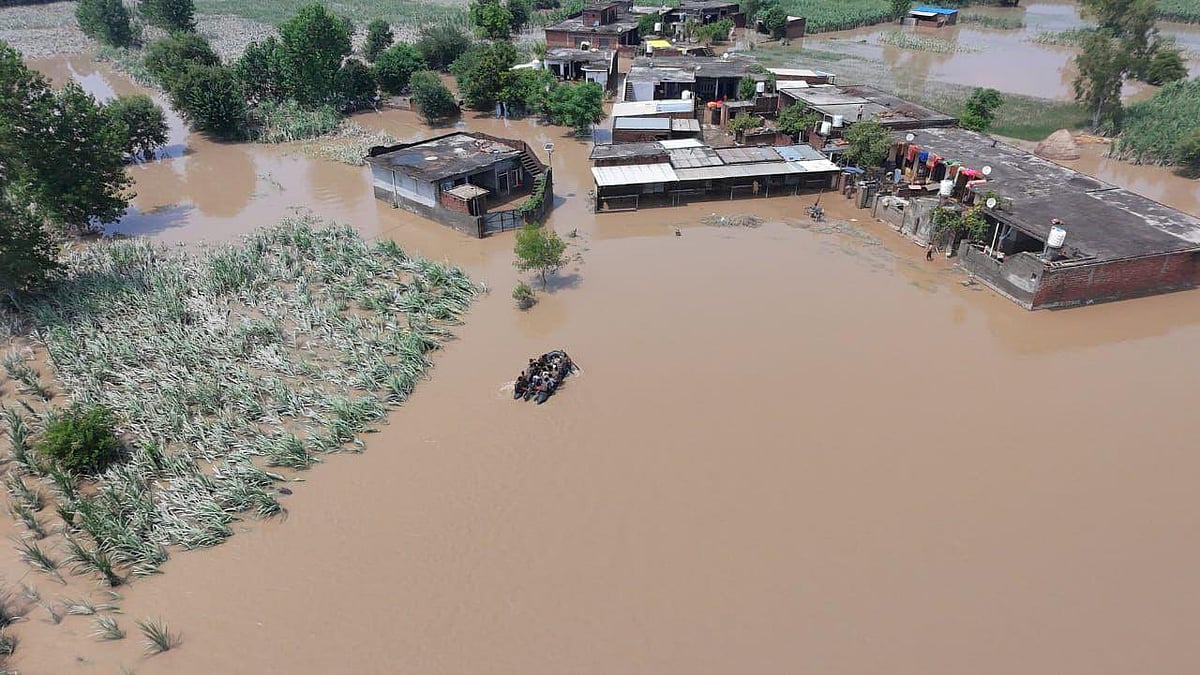
Punjab Floods 2025: From Agricultural Powerhouse to Disaster Hotspot
(09-Sep-2025)

- Punjab, known as the 'Grain Bowl of India', has witnessed its worst flood in nearly four decades.
- Affected population: ~4 lakh people
- Deaths: 48 confirmed
- Villages submerged: Over 2,000
- Economic loss: ₹13,000+ crore
- Agricultural loss: 1.72 lakh hectares of crops destroyed
- Crisis highlights vulnerabilities: Climate-linked rainfall extremes & weak environmental safeguards.
Climate Dynamics and Meteorological Factors
- Punjab recorded 591.8 mm rainfall (June–Sept), 53% higher than normal.
- Sudden, high-intensity downpours replaced steady monsoons.
- Heavy upstream rainfall in Himachal Pradesh & J&K swelled rivers Sutlej, Beas, Ravi.
- Climate change drivers:
- Warming of the Arabian Sea added more moisture to monsoon winds.
- Frequent cloudbursts in northern India.
- IPCC warnings of increasing extreme rainfall events in Himalayan & sub-Himalayan zones.
Human-Induced Vulnerabilities
- Encroached Drainage Systems – floodplains and natural drains replaced by settlements.
- Illegal Sand Mining – weakened riverbeds & embankments, altering flow.
- Poor Dam Management – full-capacity reservoirs released water suddenly.
- Neglect of Preventive Measures – desilting, drainage cleaning, embankment strengthening ignored.
- Construction in Risk Zones – buildings on riverbanks blocked natural water pathways.
Lessons Ignored from History
- Major floods: 1988, 2004, 2008, 2010, 2013, 2019, 2023.
- 1988 floods killed 500+ people.
- Reforms remained piecemeal and reactive.
- Encroachment, weak embankments, and unregulated mining worsened cumulative risks.
Humanitarian and Economic Fallout
- Humanitarian Losses:
- 22,000+ people evacuated.
- Relief camps face food insecurity, sanitation issues, disease risks.
- Women, elderly, and children disproportionately affected.
- Agricultural Crisis:
- Over 4 lakh acres submerged.
- Paddy, basmati, wheat, maize, cotton, sugarcane destroyed.
- Soil fertility hit by silt deposits and erosion.
- Threat to Public Distribution System (PDS) food security.
- Infrastructure Breakdown:
- Roads, bridges, power supply damaged.
- Industrial hubs like Ludhiana hit by urban flooding.
- Supply chains disrupted.
- Public Health Hazards:
- Risk of cholera, typhoid, hepatitis A.
- Dengue & malaria risks due to stagnant waters.
- 'Black Flood' in Ludhiana from toxic Buddha Dariya overflow.
Ecological and Environmental Impact
- Deforestation reduced slope stability.
- Wetland encroachment cut natural water cushions.
- Wildlife corridors and habitats disturbed.
- Soil erosion and land degradation threaten long-term agriculture.
- Fragile Himalayan ecosystem adds to downstream risks.
Global Best Practices for Flood Resilience
- Japan – strict zoning & advanced warning systems.
- Netherlands – basin-level water planning & dike systems.
- Bhutan – community-based preparedness for glacial floods.
- India must adapt such models in flood-prone plains & Himalayan foothills.
Pathways to a Resilient Punjab
- Strengthening Preparedness:
- Real-time forecasting & village alerts.
- Mock drills for disaster readiness.
- Eco-Sensitive Development:
- Ban on floodplain construction.
- Carrying-capacity studies for projects.
- Vegetation for slope stabilization.
- Improved Water Management:
- Integrated river basin planning.
- Smart dam operations with predictive release.
- Wetland and traditional water system restoration.
- Agricultural Adaptation:
- Promote climate-resilient crops.
- Diversify away from water-intensive monocultures.
- Expand PM Fasal Bima Yojana insurance.
- Institutional Reforms:
- Strengthen NDMA & empower panchayats.
- Integrate climate adaptation in state planning.
- Promote community participation in embankment upkeep.
Conclusion: Beyond Relief to Resilience
- Punjab Floods of 2025 are not only a natural calamity but worsened by governance failures & climate change.
- Future strategy must shift from reactive relief to preventive planning.
- Focus on institutional reforms, eco-sensitive growth, and sustainable agriculture.
- Punjab’s tragedy is also an opportunity to build resilience and long-term preparedness.

